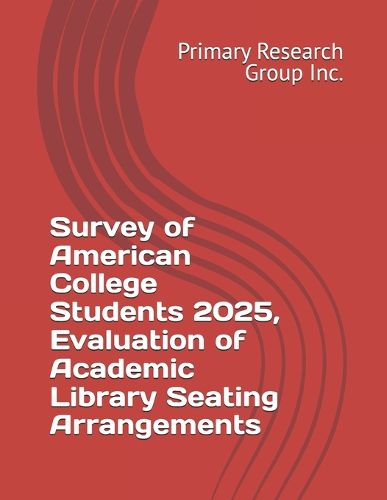Readings Newsletter
Become a Readings Member to make your shopping experience even easier.
Sign in or sign up for free!
You’re not far away from qualifying for FREE standard shipping within Australia
You’ve qualified for FREE standard shipping within Australia
The cart is loading…






The survey, conducted with 922 students, provides valuable insights into how different demographics utilize library seating and their satisfaction levels with various seating arrangements. The study looks at preferences for group vs. individual seating, the need for group and individual study rooms, interest in non-conventional seating, and much more. Survey participants rate the relative importance of noise control, lighting, accessible power outlets and mobile device charging options, among other characteristics.
Just a few of this 179-page report's many findings are that:
26.22% of respondents use library seating daily or a few times per week. Younger students, particularly those under 20, are more frequent users of library seating, with 11.99% using it daily and 23.34% several times a week. In contrast, older students, especially those over 28, show a clear decline in usage, with 57.14% rarely or never using library seating. 27.52% of respondents find it "always" or "often" difficult to find a seat during peak hours. 44.75% of students consider a quiet environment "very important," with another 30.12% marking it as "somewhat important." Satisfaction with library seating quality varies, with 39.54% rating it as "high quality," but 34.02% rating it as "neither high nor low quality," indicating room for improvement. Student interest in ergonomic seating and modular furniture was strong; demand for unconventional seating options like beanbags and standing desks was less strong but still significant.
The survey highlights the need for academic libraries to consider demographic variations and preferences when designing seating arrangements. Enhancing seating comfort, accessibility, and privacy can significantly improve student satisfaction and engagement. Data in the report is broken down by many institutional and personal variables including but not limited to academic major, gender, age, income level, region or origin, college enrollment size, tuition level and many other variables.
$9.00 standard shipping within Australia
FREE standard shipping within Australia for orders over $100.00
Express & International shipping calculated at checkout
The survey, conducted with 922 students, provides valuable insights into how different demographics utilize library seating and their satisfaction levels with various seating arrangements. The study looks at preferences for group vs. individual seating, the need for group and individual study rooms, interest in non-conventional seating, and much more. Survey participants rate the relative importance of noise control, lighting, accessible power outlets and mobile device charging options, among other characteristics.
Just a few of this 179-page report's many findings are that:
26.22% of respondents use library seating daily or a few times per week. Younger students, particularly those under 20, are more frequent users of library seating, with 11.99% using it daily and 23.34% several times a week. In contrast, older students, especially those over 28, show a clear decline in usage, with 57.14% rarely or never using library seating. 27.52% of respondents find it "always" or "often" difficult to find a seat during peak hours. 44.75% of students consider a quiet environment "very important," with another 30.12% marking it as "somewhat important." Satisfaction with library seating quality varies, with 39.54% rating it as "high quality," but 34.02% rating it as "neither high nor low quality," indicating room for improvement. Student interest in ergonomic seating and modular furniture was strong; demand for unconventional seating options like beanbags and standing desks was less strong but still significant.
The survey highlights the need for academic libraries to consider demographic variations and preferences when designing seating arrangements. Enhancing seating comfort, accessibility, and privacy can significantly improve student satisfaction and engagement. Data in the report is broken down by many institutional and personal variables including but not limited to academic major, gender, age, income level, region or origin, college enrollment size, tuition level and many other variables.